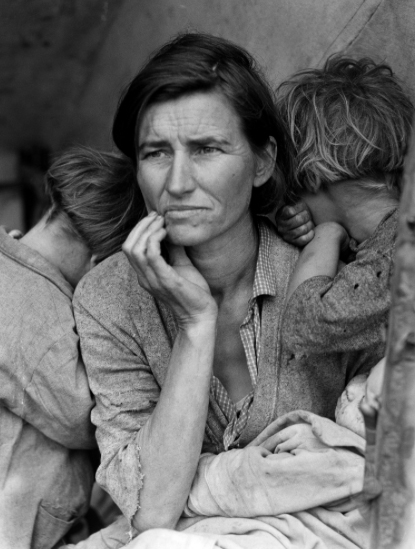Documentary Photograpy – pondering on the subject.
By Michelle Chaplow
In the 20th century “Newspapers and magazines came to rely on photographic illustrations to underscore the meaning of their stories and, conversely, text was called upon to shape viewers’ understanding of even seemingly straightforward pictures”.
This statement from Sarah Meister, photography curator at Museum of Modern Art, in New York, reminds us of the power of photography – that the story is not as powerful without a photograph. Photography can very quickly convey a message and shape opinions.
Documenting history
Photos that are taken today will eventually turn into historic documents. Dorothea Lange´s Migrant Mother, taken in the 1930s, is now an iconic image of the Great Depression in the United States. The government’s Resettlement Administration commissioned Dorothea to illustrate the effects of the Depression on the population.
Photo source Wikipedia
The tension, the closeness of the frame and the preoccupied look of the young mother, capture one of the most difficult times for many families in America.
Visual interpretation
It is the picture that can often ‘sell’ the story and create engagement with the reader. Newspaper and magazine editors acknowledged this, and editorial photographers were hired to ‘tell the story’ and convey the message, as Dorothea did. She could also have captured the children in a playful mood, which would have conveyed a very different message
Documentary photographers can be restricted by editorial guidelines. In personal projects, the photographer can create images that are intentionally thought-provoking, such as we see in the work of Gary Winogrand’s photograph of a blonde woman and African-American man carrying two monkeys.
Changing the context of photographs
In 1977 Larry Sultan and Mike Mandel created a project called Evidence. Taking photographs from industrial archives, showing apparently unconnected machines and experiments, their book has no words, but it shows how images can sit beside each other, often bearing no relation. All the images are documenting something – is this now the truth? Was it ever the truth? The pictures take on a new meaning and we have to question the “evidence”.
It makes you question: is documentary photography real?
Who can say what is real, because you never know what is outside the frame – is it reality or false reality? Can you ever accurately depict the whole scene on camera? Can documentary photography ever be real?
In an interview with Susan Meiselas for her project Carnival Strippers 1972-75, it was very interesting to note that she took the photos in public fairgrounds with many other people surrounding her in the audience.
“There weren’t many other cameras. I mean if we were making this picture today it’s interesting the differences of how many people would have been with cameras, iPhones, etc. So I don’t think she’s performing for me. She’s performing for the public. I think now we find many more people performing for the cameras”.
This is a very interesting point and it’s one of the major changes in photography. It also brings to mind the performance within a performance.
Documentary photography and hotels
Hotels with the passage of time earn their history, an archive of documentary photographs, will remind the viewer of important events and how the hotel changes and evolves.
These same photos will be interpreted differently by different viewers. A chef will see things in a photograph of his hotel kitchen, in a different way to a guest or the receptionist. The meaning of the images will be unique to each viewer, albeit objective or subjective. An archive of documentary photographic images images will be an invaluable future asset to any hotel.
Can you see what I see?
Sarah Meister, Curator of the Photography Department at MOMA, says that “People are so accustomed to making a direct parallel between a photograph’s subject and its meaning”. Yet to me, there are so many non-parallel explanations.
Can you see what I see? The answer that I would give is no, we can´t, because our interpretation of an image is determined by our own thoughts, emotions and mindset at the time. The intrinsic meaning of photography can change and the same image will never convey the same meaning to everyone.


